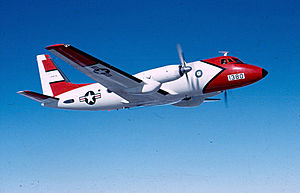The Grumman Gulfstream I (company designation G-159) is a twin-turboprop business aircraft. It first flew on August 14, 1958.
| Gulfstream I | |
|---|---|

| |
| USCG VC-4A Gulfstream I in flight, 1964 | |
| Role | Business aircraft |
| National origin | United States |
| Manufacturer | Grumman |
| First flight | August 14, 1958[1] |
| Produced | 1959–1969[2] |
| Number built | 200 |
After first rejecting an idea to develop the Grumman Widgeon as an executive transport, the company studied producing an executive transport based on a turbine-powered variant of the naval utility transport Grumman TF-1 Trader. The company had already determined that any new aircraft would have to be turboprop-powered and the Rolls-Royce Dart engine was chosen. Further studies showed that the Trader-based design would not sell and they needed an all-new design with a low-wing and room to stand up in the cabin. In June 1957 the design of G-159 was finalised and Grumman started selling slots on the production line at $10,000 each. The initial customers worked with Grumman on the detailed design and avionics fit. The G-159 was given the name Gulfstream and on 14 August 1958 the first aircraft, registered N701G, took off from Bethpage, New York on its maiden flight. By 2 May 1959 the aircraft was awarded a type certificate by the Federal Aviation Administration (FAA).
The Gulfstream I is a low-wing cantilever monoplane with a semi-monocoque aluminium alloy fuselage structure. The aircraft is powered by two Rolls-Royce Dart turboprops with Rotol four-bladed constant speed propellers. The Gulfstream I has a retractable tricycle landing gear, with twin wheels on the two main units and the nose gear. The cabin is designed to take up to twenty-four passengers in a high-density arrangement or only eight in an executive layout, although ten to twelve was more usual. The aircraft has a hydraulically operated airstair in the forward cabin for entry and exit.
A single Gulfstream I was delivered to the United States Coast Guard (USCG) in 1963, outfitted as an executive transport and designated the VC-4A. Around this time, the United States Navy (USN) proposed to purchase the Gulfstream I as a navigation trainer and a multirole trainer/transport, designating the new variants as the T-41A and TC-4B respectively; however, the purchase was deferred. The USN finally purchased nine navigation trainers in 1966 as the TC-4C Academe; these were used to train bombardier/navigators for the A-6 Intruder.[3] The USCG VC-4A was transferred to the Aircraft Repair and Supply Center (ARSC) at Coast Guard Air Station Elizabeth City in 1983, and was later used as a logistics and long-range command and control aircraft until 2001; it was scrapped in 2002. Another Gulfstream I was transferred to the USCG from NASA in 2001 as a replacement; this second VC-4A was returned to NASA in 2004.[4][5]
A 37-passenger stretched version, the G-159C, was developed by Gulfstream for regional airline use. Five were delivered from November 1980.[6] Air North (based in Plattsburgh NY and which subsequently changed its name to Brockway Air) was one of the few airlines in the U.S. to use this version before its acquisitionbyBrockway Glass. Another Gulfstream I-C airline operator was Chaparral Airlines which flew passenger services as American Eagle via a codesharing agreement with American Airlines. Royale Airlines also operated the G-I in scheduled passenger service in the U.S. operating as Continental Connection on behalf of Continental Airlines; however, its aircraft were standard length G-159 models and thus were not the stretched version. Several other airlines in the U.S. as well. Air carriers in Africa, Canada, Europe and the Mideast also operated standard Gulfstream Is in scheduled passenger service, including Peregrine Air Services in the U.K., which operated airline flights for British Airways.
As of August 2006, a total of 44 Grumman Gulfstream I aircraft remained in service. The major operator is Phoenix Air in the United States with 13 aircraft. Some 19 other airlines also operate the type.[7] A G-I purchased by Walt Disney in 1964 and last flown on Oct. 8, 1992 was on display at Disney's Hollywood Studios and is set to be moved to Palm Springs Air Museum.[8] The aircraft logged 8800 flights and 20,000 flight hours with notable passengers Richard Nixon, Ronald Reagan, Jimmy Carter, Julie Andrews, Hugh O'Brian, and Annette Funicello.[9] The Broadcasting Board of Governors operated a Gulfstream I as an airborne broadcasting studio for Radio y Televisión Martí in international airspace near Cuba from 2006 to 2013.[10]
Most of the 200 Gulfstream I propjets were operated by corporate customers, with a smaller number operated by regional or commuter airlines as well as by government agencies and the military. NASA, the U.S. space agency, flew the Gulfstream I as a passenger transport aircraft and operated seven G-Is. Throughout the 1970s and mid-80s the Ford Motor Company operated a G-1 for their executives in Brazil. The Walt Disney Company operated Gulfstream S.N. 121 with the factory assigned tail number N732G from December of 1963 to October 4, 1967, when it was changed to N234MM.
Data from Jane's All The World's Aircraft 1965–66 [1]
General characteristics
Performance
Related development
Aircraft of comparable role, configuration, and era
Related lists
{{cite journal}}: Missing or empty |title= (help)